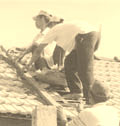
A programme to promote preventive strengthening to protect homes and family investment.
The DWF programme in Central Viet Nam demonstrates a strategy that channels resources, including each family’s own resources into prevention rather than post disaster reconstruction. Building on earlier Viet Nam experience between 1989 and 1993, DWF has been working in the central province of Thua Thien Hué with families and communities to help make people aware of what should be done to reduce vulnerability, aware of how to do it, and how to put this into practice.
 The
programme creates the institutional, technical and financial environment -
with credit for strengthening - in which prevention can take place,
and in collaboration with families demonstrates how strengthening can be done
at a fraction of the cost of reconstruction. The current programme is supported
by ECHO European Commission Humanitarian Aid Office.
The
programme creates the institutional, technical and financial environment -
with credit for strengthening - in which prevention can take place,
and in collaboration with families demonstrates how strengthening can be done
at a fraction of the cost of reconstruction. The current programme is supported
by ECHO European Commission Humanitarian Aid Office.
See: Establishing community capacity to reduce vulnerability caused by storm damage to houses and public building, Central Viet Nam
Present Work
Establishing community capacity to reduce vulnerability caused by storm damage to houses and public building, Central Viet Nam. DWF promotes and supports preventive action to reduce future vulnerability in shelter.
Vulnerability in domestic shelter and small infrastructure in Central Vietnam
is a critical and under supported issue.
- Families are extremely poor but over the past decade have been steadily investing in better houses and living conditions.
- This investment is insecure, because preventive storm resistant techniques are not applied. Small public infrastructure - schools and markets are equally at risk of damage and economic loss.
Context
Each time storms hit the coast of Central Viet Nam flooding and destructive
winds cause major damage. The result is the loss of homes and infrastructure
and the loss of investment in the home and in the quality of life and the
security of livelihoods. Instead of developing and improving their lives,
many villagers are in an almost constant state of recovery.
Overall, although damage in massive storms is hard to avoid, in the more frequent
lesser cyclones the level of damage is much higher than it need be. Prevention
can and does reduce this.
Why the increased vulnerability?
Domestic investment in building materials over the past decade has increased
significantly. But this investment has not been matched by a similar increase
in quality and strength in new houses. Buildings still have many weaknesses
that expose their owners to loss.
This risk represents a level of vulnerability that is both unnecessary and
unacceptable. For all but the largest storms, most damage can be avoided by
preventive strengthening of existing buildings.
DWF addresses this issue through awareness raising, practical demonstration and policy change.
The aim is to reduce vulnerability and damage in houses and small infrastructure:
- Preventive strengthening reduces the risk of damage.
- A reduced risk of damage helps secure family investment in shelter.
- Lower risk enables family investment in improvements instead of repairs.
Action in the communes works to:
- engage solid provincial support
- change strategies to place domestic strengthening as a central issue
[continue]
